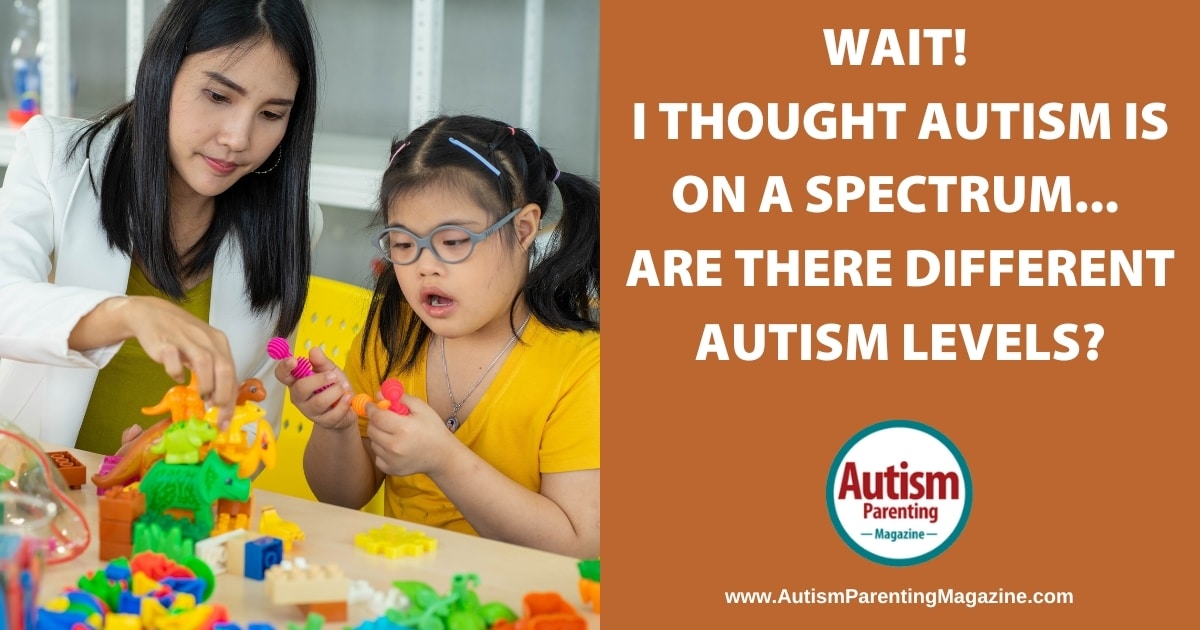
An autism diagnosis can bring a lot of uncertainty. One of the first things families learn is that it is a spectrum, hence autism spectrum disorder (ASD). But did you know there are different autism levels?
Besides being on a spectrum (low to high-functioning autism), not many parents know that the 5th edition of the Diagnostic and Statistical Manual of Mental Disorders (DSM-5) specifies different autism levels.
Every child is unique and built with strengths, drives, and interests. There is no such thing as a ‘”one size fits all” approach when diagnosing and treating autism symptoms. Therefore, many experts argue it makes sense to recognize different autism levels.
Let’s take a closer look.
What Are the Different Autism Levels?
The three levels of autism spectrum disorder are:
- Level 1 – Requiring support
- Level 2 – Requiring substantial support
- Level 3 – Requiring very substantial support
Within each of these autism levels, specific factors define the level and what challenges are faced at that level.
Autism Level 1: Requiring Support
At this level, the autistic person would exhibit some difficulty with social communication. This could make it difficult for the individual, and they may show the following behaviors:
- challenges starting social interactions
- difficulty interacting and understanding others
- may not show interest in social interactions
- less flexible, making it difficult to focus on different scenarios
- difficulty coping with and changing activities
- exhibits organization and planning difficulties
Autism Level 2: Requiring Substantial Support
At this level, social communication deficits are more pronounced and don’t only include difficulty with communicating verbally but may include delayed development of nonverbal communication. Some additional support will be necessary with social interaction, as well as social communication. Other indicators are:
- social communication and interactions still being difficult despite support being present
- limited ability to initiate and maintain social communication and interactions with others
- inflexible behavior, especially when dealing with unexpected changes
- restricted interests
- repetitive behaviors more consistent and visible to others
Autism Level 3: Requiring Very Substantial Support
When an autistic person is at a very substantial support level, there are symptoms of more intensive verbal and nonverbal communication difficulties, including:
- difficulty coping and functioning
- restricted interests and initiation of social communication and interactions
- inflexible and restrictive behaviors
- extreme difficulty dealing with any change
- repetitive behaviors that disrupt daily life
- severe distress when switching from one activity to another, disrupting focus
Click
here to find out more
On What Autism Level is my child?
Many terms and diagnoses surround diagnosing autism spectrum disorder. A few of these would include:
After considering the different autism levels, how do you know at what level your child is?
It is essential to talk to the child’s doctor or another medical professional when wondering about autism and any additional terms and diagnosis that can go hand in hand with a diagnosis. Doctors and other medical professionals have the tools and support to provide a diagnosis and potential referrals for their patients.
This process doesn’t mean taking a passive back seat. You are with your child more than anybody else and know them better. You can observe your child’s functioning and potential autism level and relay this information to your doctor.
Having an open conversation with the child’s doctor would be a significant first step. The doctor can then proceed with the diagnosis and talk to the parents and child about what they can expect and who else they may talk to.
In Conclusion
Every child is unique and has their own set of strengths and challenges. As no two children are alike, no two autistic people are alike, and their journeys will look completely different from one another’s. It is good and completely normal for parents to have questions about their child’s autism diagnosis and what support could be available.
Observing your child’s potential autism level and speaking to a professional about the different possibilities can ensure your child gets the best possible support that is just right for them.
References:
American Academy of Pediatrics. (2020). Identification, Evaluation, and Management of Children With Autism Spectrum Disorder. https://publications.aap.org/pediatrics/article/145/1/e20193447/36917/Identification-Evaluation-and-Management-of
Coolidge, F., Harris, L., Nolan, S., Schroeder, R., & Segal, D. (2022). Differentiation of children with varying levels of autism spectrum disorder symptoms from children developing typically. https://www.sciencedirect.com/science/article/pii/S2772598722000654
The post Wait! I Thought Autism Is On A Spectrum… Are There Different Autism Levels? appeared first on Autism Parenting Magazine.
Get a FREE issue of Autism Parenting Magazine at https://www.autismparentingmagazine.com/freegift/
This content was originally published here.
